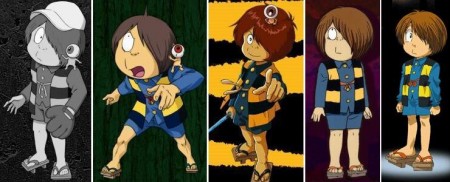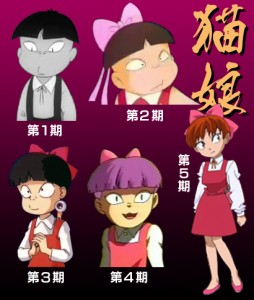Ask John: How Did Kitaro Turn Moe

Question:
I have noticed NekoMusume is in a different outfit on every Gegege no Kitarou 00s cover (because she often wears different costumes in episodes, trying various kinds of human jobs.) I wonder if that’s a barbie-like element or a cosplay element. I’m definitely reminded by going though all these discs that Gegege has gotten progressively cuter character designs, to the point where Kitarou and NekoMusume are considered moe characters. I’m just wondering why Gegege no Kitarou keeps on getting cuter and cuter with each incarnation.
Bit o’ trivia: Gegege 00s is the first Gegege series to have a different ending theme song. Guess the desire to plug a new single
finally outweighed following tradition.
Answer:
From an outsider’s (i.e. a non-Japanese) perspective, the evolution of anime incarnations of the Ge Ge Ge no Kitaro cast from shadowy monsters to adorable mascots may seem bizarre. Since I’m one of those “outsiders” myself, I can’t be certain that my theory is correct, but I do think that this long and slow evolution is actually quite natural given the unique character of Japanese popular culture. The transformation of particularly Kitaro and Neko Musume from hunched, furitive, frightening monsters to moe-inducing shonen-manga style heroes is probably a result of nostalgic familiarity and Japan’s distinctive fondness for prettying things usually considered repulsive. Of course, marketing opportunities can’t be overlooked either.
Creator Shigeru Mizuki’s Ge Ge Ge no Kitaro manga and its characters originated from the early 20th century Japanese folktale Hakaba no Kitaro, which itself emerged from ancient Japanese superstitions about native Japanese monsters and spirits. So the Kitaro character has been an integral part of Japanese culture for generations. Mizuki’s unique adaptation of the Kitaro character and his companions premiered in 1959 and has become part of modern Japanese cultural iconography. New Ge Ge Ge no Kitaro anime TV series have premiered in 1968, 1971, 1985, 1996, and 2007 – one each decade over the past 50 years. The series’ stories haven’t changed much at all in fifty years, but the anime character designs have changed dramatically. In the earliest Kitaro anime, Kitaro himself and Neko Musume resembled the stereotypical image of an “Igor” mad scientist’s assistant – short, crooked, pale, and likely to pounce with gnashing teeth and claws at any moment. Kitaro was originally eager to protect the safe distance that separated the human and yokai realms. Neko Musume was a relatively little seen supporting character. In the contemporary Ge Ge Ge no Kitaro anime, Kitaro himself is an aggressive champion of justice who defends the human world from malicious yokai. Neko Musume has become a prominent character who’s more frequently an extended visitor in the human world than a resident of the yokai world.

Like Neko Musume, the entire cast and concept of Ge Ge Ge no Kitaro has become familiar and beloved to Japanese viewers over the decades. Kitaro is no longer the suspicious and frightening outsider that invades Japanese society. He’s now the friendly defender of human society. And like a Japanese Peter Pan, Kitaro is the supernatural little boy who will never grow old. He’s become the perpetual school child’s loyal classmate, and every Japanese girl’s little brother. The feral aspect of a cat girl has given way to the feline tendency to curious, independent wandering. Like a cat that sticks its nose into everything, Neko Musume now makes a hobby of trying an assortment of human world jobs. She’s become the neighborhood stray that everyone pets and feeds, but whom no one owns. Simple familiarity has made these characters part of the family, so like adopted children, it’s natural that they’ve become cuter and friendlier over time.
Japanese culture has a unique fondness for transmogrifying ugly into cute. Cockroaches transformed from disgusting to sympathetic in 1987’s Twilight of the Cockroaches. Insects and spiders have become talking friends and partners in Spider Riders and Mushiking. Bacteria became adorable in Moyashimon. Monsters became collectable in Digimon (Digital Monsters) and Pocket Monsters. And the traditional spooks of Japanese myth became familiar and cute in Ge Ge Ge no Kitaro. The status of Kitaro and Neko Musume as beloved and nostalgic characters; the Japanese fascination with small, weird, cute things; natural progession in the visual style of modern anime; and the contemporary emergance of the moe phenomena have all affected the development of Ge Ge Ge no Kitaro anime, and certainly can’t have escaped the notice of Toei Animation executives and staff that have capitalized on this natural evolution.

